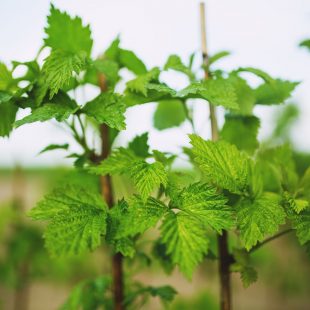Mutants and Clones of Pinot Noir

Pinot noir is almost certainly a very ancient variety that may be only one or two generations removed from wild, Vitis sylvestris, vines. Its origins are nevertheless unclear: In De re rustica, Columella describes a grape variety similar to pinot noir in Burgundy during the 1st century CE, however, vines have grown wild as far north as Belgium in the days before phylloxera, and it is possible that Pinot represents a direct domestication of (hermaphrodite-flowered) Vitis sylvestris.
Ferdinand Regner has argued that pinot noir is a cross between Pinot Meunier (Schwarzriesling) and Traminer, but this claim has since been refuted. In fact Pinot Meunier has been shown to be a chimerical mutation (in the epidermal cells) which makes the shoot tips and leaves prominently hairy-white and the vine a little smaller and early ripening. Thus Pinot Meunier is a chimera with two tissue layers of different genetic makeup, both of which contain a mutation making them non-identical to, and mutations of, Pinot noir (as well as of any of the other color forms of Pinot). As such, Pinot Meunier cannot be a parent of Pinot noir, and, indeed, it seems likely that chimerical mutations which can generate Pinot gris from other Pinots (principally blanc or noir) may in turn be the genetic pathway for the emergence of Pinot Meunier.
Pinot noir can be particularly prone to mutation (suggesting it has active transposable elements), and thanks to its long history in cultivation there are hundreds of different clones in vineyards and vine collections worldwide. More than 50 are officially recognized in France compared to only 25 of the much more widely planted Cabernet Sauvignon. The French Etablissement National Technique pour l’Amelioration de la Viticulture (ENTAV) has set up a program to select the best clones of Pinot. This program has succeeded in increasing the number of quality clones available to growers. In the new world, particularly in Oregon, wines of extraordinary quality continue to be made from the (ex-University of California at Davis) Pommard (principally UCD4) and Wadensvil (UCD 1A and / or 2A) clones.
Gamay Beaujolais is a Californian misnomer for a UCD clone series of upright-growing (‘Pinot droit’) Pinot noir. Planted mostly in California it also became established in New Zealand. In this latter country, its disposition to poor fruit set in cool flowering conditions can be problematic. Claims that the ‘Gamay Beaujolais’ Pinot noir was brought to California by Paul Masson are not correct. It was collected in France by Harold Olmo for UCD in the 1950s and was one of the first Pinot noir vines this institution offered as a high health clonal line from about 1962 onward. However, it was misleadingly identified at UCD as a ‘Gamay Beaujolais’ type (of Pinot noir). In general, these upright growing ‘Pinot droit’ clones are highly productive (in suitable, hot-to-warm, flowering conditions) and in California and New Zealand they give robust, burly, wines favored by those who like muscle rather than charm and velvety finesse in their Pinot noir wines. In Burgundy, the use of (highly productive) Pinot droit clones is reportedly still widespread in inferior, Village appellation, or even non-appellation, vineyards and Pinot droit is consequently regarded, arguably with very good reason, as a (genetic) sub-form significantly inferior to classical, decumbent, ‘Pinot fine’ or ‘Pinot tordu’, clonal lines of Pinot.










